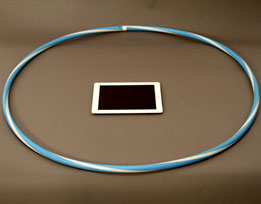Following the example in the video Exploring Small Spaces, children look very closely at a small patch of ground to see what living things they can discover.
Materials

- String or a hula hoop for each group approximately 1–3 feet in diameter)
- 1 iPad for each adult
Preparation
- Find a safe, grassy outdoor area where children can explore small spaces of grassy ground to discover what sort of living things—plant or animal—are living there, like the children did in the video Exploring Small Spaces.
- If possible, enlist several adults to join the class during the outdoor exploration.
- SAFETY ALERT: Check the areas where you will take children. Look out for traffic, glass and other litter, poison ivy and other plants that can cause rashes, and any bushes with thorns. Be sure to tell children not to touch any plants or critters without first asking an adult.
Directions: Lesson 10
Outdoors
Children will explore in small teams. The adults can circulate among the teams, talking with children about their discoveries and taking videos with the iPads.
- Tell children that they will be going to a safe outdoor area, just like the kids in the Exploring Small Spaces video. There, they will work in small groups to explore the living things they find in their own “small spaces.” Have them recall some of the plants and animals the children in the video discovered.
- When you get to the grassy area, place a hula hoop or a circle of string on the ground for each group. Have the groups of children look carefully at the plants growing inside their circle, as well as any seeds and plant parts on the ground.
- Take videos of each group as they show some of the things they have discovered in their small space and respond to some of these questions:
- What do you observe in the small space you are exploring? What living things can you see?
- Can you find two plants that are in your small area? Compare the two plants and describe how they are the same or different, such as in size (big or small), color, number of leaves, and so on.
- Can you find any seeds or nuts? Describe how they are the same or different.
- What’s the smallest leaf you can find? The biggest leaf?
- Can you find a plant with a green stem? A plant with a stem that is not green?
- Do you think grass is a living thing? Why do you think that?
- Do you see any bugs or worms in your area? Are they living things too? How do you know?
- If possible, find a small weed and tell children that weeds are plants that grow where they are not wanted. People pull weeds out of their gardens so they will not crowd out the fruits and vegetables they planted.
- Gently tug on the weed without uprooting it. I wonder what is keeping the plant attached to the ground. Let’s find out.
- Carefully pull up the weed from the ground to show children what the roots look like.
- Discuss how roots take in water and nutrients from the soil to help the plant grow.
- Later, in Our Outdoor Discoveries, you will share these videos with the class.


